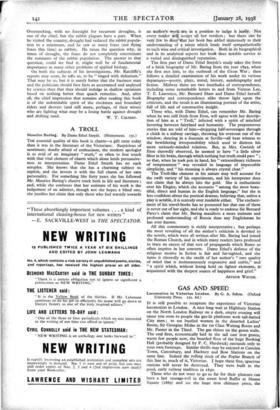GAS AND SPEED
Locomotion in Victorian London. By G. A. Sekon. (Oxford University Press. tar. 6d.) IT is still possible to recapture the experience of Victorian locomotion in London. A nice long wait at Highbury Station on the North London Railway on a dark, empty evening will cause you soon to people the gas-lit platforms with tall-hatted City men ; to see bustled women in the deserted Ladies' Room, Sir Georgius Midas in the 1st Class Waiting Room and Mr. Pooter in the Third. The gas shines on the green walls. The coal fires, economically laid in the tall cast iron grates, warm few people now, the boarded floor of the huge Booking' Hall (probably designed by P. C. Hardwick) resounds only to your own footsteps. Similar thrills may be enjoyed at Camden Town, Canonbury, and Hackney and Bow Stations on the same line. Indeed the rolling stock of the Poplar Branch of this line is, much of it, Victorian. I hope these fine, spacious stations will never be destroyed. They were built in the good, early railway tradition in 185o.
Those who do not want to go so far for their pleasure can have a last sausage-roll in the street level Buffet at Sloane Square (1869) and see the huge iron chimney piece, the
gas-standards and the bar fittings before Progress has destroyed them.
The experience of the old steam underground railway can still be enjoyed by anyone entering an up train at King's Cross (York Road Station) and travelling to, let us say, Aldersgate Street, in one of those unaccountable steam trains. He can make an even longer underground journey from Kentish Town (Midland) to the same station. Mr. Sekon's book is for Londoners who know the Metropolis fairly well, for it will dazzle those without a clear sense of London's topography. Mr. Sekon is clearly a Londoner and brings in some pleasant personal reminiscence—pick- pockets at work on an open deck 'bus, water-supply brought in pails to his father's house. He edited the Railway Magazine from 1897 to 1910 and the Railway and Travel Monthly from 1910 until 1922, so that he may be said to know his subject thoroughly. The chapters include ones on pedestrianism, omnibuses, steamboats, cabs, bicycling, trade vehicles, and a long section on railways.
The dust jacket says that this book contains information for the statistician. With the aid of the good index he will find it, but the book will give most pleasure to the other person whom the publisher recommends to read it—" the amiable student of periods and manners." Mr. Sekon does not write like a don, tracing developments to the bitter end. He has no bibliography. His is the fact-collecting mind of a para- graphist and his book reads like a series of entertaining footnotes. I found it stimulating and readable. His little tricks of style seem to suit his subject : " Rowboats . . . were also hired by the London apprentices et hoc genus, workmen on the spree, and industrial Londoners generally on holiday, to a not inconsiderable extent—the state of the weather and of the personal exchequer permitting ! "
Since this book is one of facts, I have extracted a few which may please the general reader. The London General Omnibus Company was French in origin and finance. The average speed of a 'bus in the 'sixties was 54 m.p.h. Short cuts on foot had a toll of id. on them and were called " Halfpenny Hatches." A horse 'bus ran down Farringdon Street till 1916. The original name of the Daily News was the Daily Chronicle and Clerkenwell News. The Times had a personal
grudge against' the S.E. Railway because a relation of one of its owners was sacked from the London and Greenwich Railway. The grudge lasted sixty years. The London and Blackwall started as a cable railway. Many S.E. London lines were atmospheric. The first cab shelter was erected in 1875 in St. John's Wood. The first hansom appeared in 1834. The first bicycle, of the type we see today, appeared in the 'eighties. The first oil driven 'bus appeared in 1899. Dogs were forbidden to draw carts in 1839. The G.W.R., which ran the first underground trains (Paddington to Far- ringdon Street), introduced gas light in the carriages and block telegraph signal control. Early coaches on the N.L.R. were made of papier mkhe. " Tubes " were called such because the tunnels were made of iron segments. The first tube was the City and South London (King William Street to Stockwell), opened in 189o. It was also the first electric train.
I only regret Lady Harberton's bold move in first wearing bloomers for bicycling is not mentioned, nor is my sreat- great-uncle, who invented the contraption whereby a cabby was able to open the doors of his hansom without getting down from the box.
One word on the production. Mr. Lynton Lamb's dust jacket is charming. One could have wished that the pub, Ushers had been more liberal with illustrations. Though the Oxford University Press is never conspicuously enterprising about colour-reproductions, colour plates are almost essential in a
book on this beautiful subject. JOHN BEIJEMAN.



















































 Previous page
Previous page